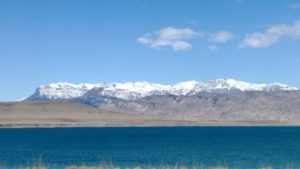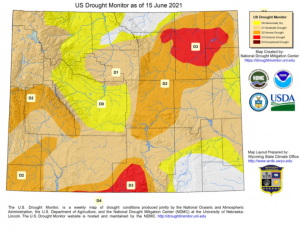Bighorn Basin Reservoirs Will Be Below Capacity in 2021
Written by Andrew-Rossi on June 22, 2021
The Buffalo Bill Reservoir will not reach capacity this year, as the Bighorn Basin continues to endure drought conditions and less snowpack runoff in 2021.
On June 22, the Bureau of Reclamation released its snowmelt forecast for Bighorn River Basin. Across the board, forecast volume for reservoirs throughout the Bighorn Basin are below the 30-year average amounts for this point in the year.
Bighorn Lake – 52%
- Bighorn River April through July inflow to Bighorn Lake is forecast to be approximately 650,000 acre-feet (a.f.), which is 52% of the 30-year average of 1,262,200 a.f. Approximately 316,000 a.f. of the forecast volume was accumulated during April and May, which is 64% of the April and May average.
Buffalo Bill Reservoir – 73%
- Shoshone River April through July inflow to Buffalo Bill Reservoir is forecast at 550,000 a.f., which is 73% of the 30-year average of 749,000 a.f. Approximately 205,700 a.f. of the forecast volume was accumulated during April and May, which is 87% of the April and May average.
Boysen Reservoir – 60%
- Wind River April through July inflow to Boysen Reservoir is forecast at 375,000 a.f., which is 60% of the 30-year average of 621,400 a.f. Approximately 143,700 a.f. of the forecast volume was accumulated during April and May, which is 74% of the April and May average.
Bull Lake Reservoir – 87%
- April through July snowmelt runoff into Bull Lake Reservoir from Bull Lake Creek is expected to be 125,000 a.f., which is 87% of the 30-year average of 144,000 a.f. Approximately 31,500 a.f. of the forecast volume was accumulated during April and May, which is 93% of the April and May average.
Wind River – 75%
- April through July snowmelt runoff into the Wind River above Bull Lake Creek is expected to be 330,000 a.f., which is 75% of the 30-year average of 437,600 a.f. Approximately 107,700 a.f. of the forecast volume was accumulated during April and May, which is 90% of the April and May average.
Inflows to the Buffalo Bill Reservoir have been normal for the winter and spring of 2021, but most of the season’s snowpack has already melted.
According to the Bureau of Reclamation, “inflows into Buffalo Bill Reservoir have been normal so far this season.” However, the snowpack in the watershed has mostly melted, and the inflows for the remainder of the summer are expected to be below average.
As a result of these reduced inflows, it’s unlikely the Buffalo Bill Reservoir will be entirely filled this year. The same scenarios and forecast hold for the Boysen and Bull Lake Reservoirs as well.
Snowpack levels have been down across the state. As early as December 2020, snowpacks were historically lower than their historical averages. During Winter 2021, those lower averages persisted.






